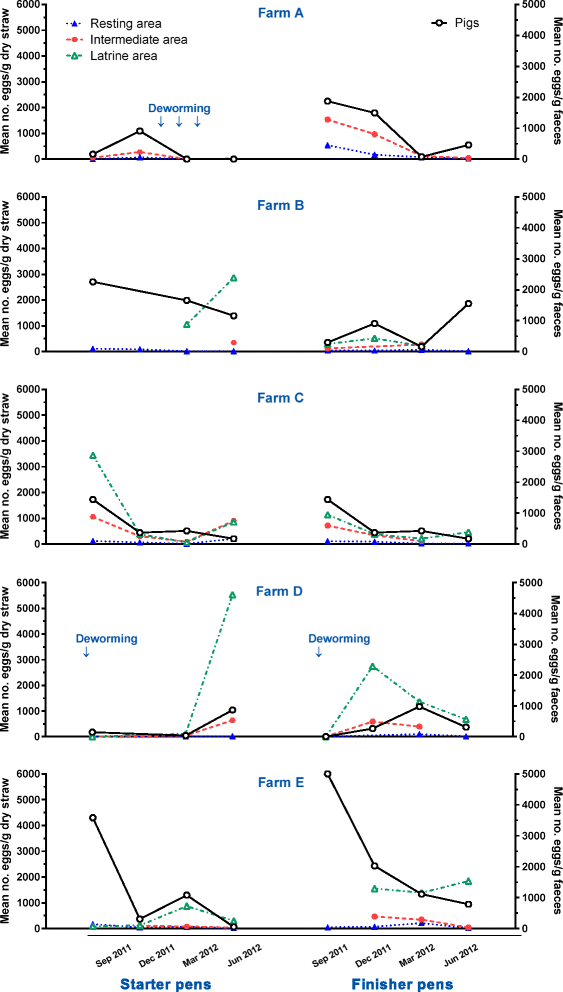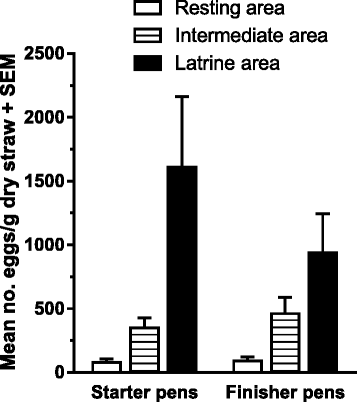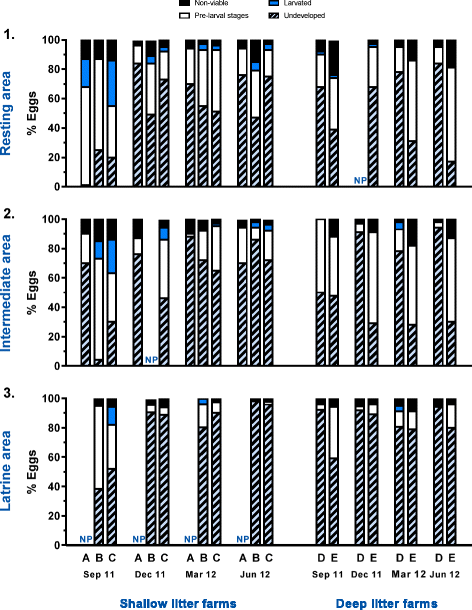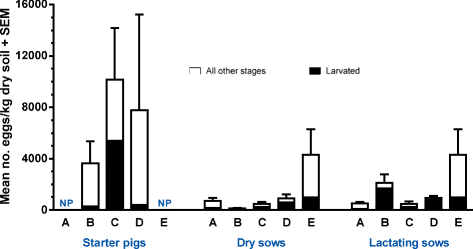Environmental contamination and transmission of Ascaris suum in Danish organic pig farms
- PMID: 26860206
- PMCID: PMC4748593
- DOI: 10.1186/s13071-016-1349-0
Environmental contamination and transmission of Ascaris suum in Danish organic pig farms
Abstract
Background: Although Ascaris suum is the most common pig nematode, the on-farm transmission dynamics are not well described.
Methods: We performed a 1-year field study on five organic pig farms, mapping egg contamination levels in pens and pasture soil as well as faecal egg counts in starter pigs, finisher pigs, dry and lactating sows. The uppermost bedding material was sampled from three pen areas (resting, intermediate and latrine) of shallow and deep litter pens.
Results: Ascaris suum was found on all farms. Averaged across farm and season, the prevalence of A. suum was 48, 64, 28 and 15% in starters, finishers, dry and lactating sows, respectively. For starters and finishers, the prevalence varied with season increasing towards the end of the year when 83-96% of finishing pigs from each farm had fresh liver white spots. Farrowing pastures were contaminated with a mean of 78-171 larvated eggs/kg dry soil depending on farm, while pastures for starter pigs contained 290-5397 larvated eggs/kg dry soil. The concentration of eggs in soil was highest in the autumn. Indoors, all pen areas were contaminated with A. suum eggs at comparable levels for shallow and deep litter. Overall there were 106, 445 and 1331 eggs/g dry straw in the resting, intermediate and latrine areas, respectively. However, more eggs were undergoing development in resting areas (44%) compared to intermediate (33%) and latrine areas (13%). Irrespective of area, more eggs were undergoing development in the autumn, but overall there were very few fully developed (i.e., infective) eggs in the bedding material. Laboratory embryonation of eggs from the bedding material nevertheless revealed that an overall mean of 79% of the eggs were viable.
Conclusion: The organic pigs of all ages were continuously exposed to A. suum, but mainly younger animals were infected. Deep litter appeared to be a less important source of A. suum eggs than previously believed compared to shallow litter. Long-term pasture rotation to eliminate pasture contamination was not possible, and control programs should therefore include thorough cleaning indoors and composting/long-term storage of bedding material and manure to inactivate eggs and reduce transmission to pigs.
Figures






References
-
- Roepstorff A, Jørgensen RJ, Nansen P, Henriksen SA, Skovgaard Pedersen J, Andreasen M. Parasitter hos økologiske svin (Parasites in organic swine) 1992.
-
- Holmgren N, Nilsson O. Inverkan av produktionsplanering och skabbsanering på tarmnematoder hos BIS-grisar. 1998. pp. G37–97.
-
- Sanchez-Vazquez MJ, Smith RP, Kang S, Lewis F, Nielen M, Gunn GJ, et al. Identification of factors influencing the occurrence of milk spot livers in slaughtered pigs: a novel approach to understanding Ascaris suum epidemiology in British farmed pigs. Vet Parasitol. 2010;173:271–9. doi: 10.1016/j.vetpar.2010.06.029. - DOI - PubMed
Publication types
MeSH terms
LinkOut - more resources
Full Text Sources
Other Literature Sources

